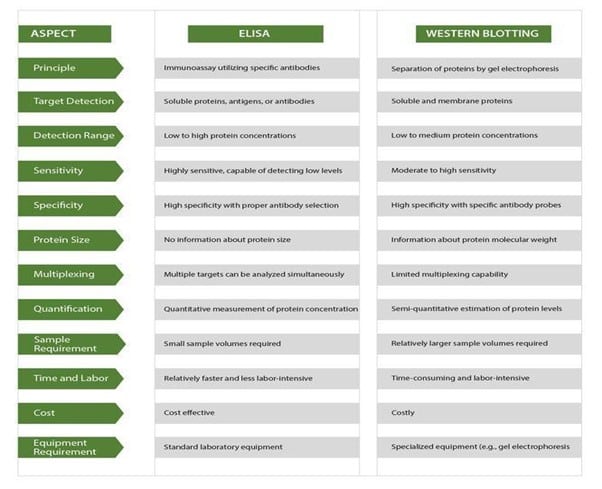ELISA vs western blot: a comparison of two common immunoassays
In biomedical research, the word “immunoassay” is common terminology. That there are different types of immunoassays is common knowledge for someone working in a laboratory.
What is an immunoassay?
Immunoassay is a technique that evaluates the presence and concentration of a macromolecule in a given solution with the help of antibody-antigen interaction or reaction.
In some of our previous articles, we highlight two kinds of immunoassays – ELISA and Western blot – widely used as bioanalytical measures for protein concentration analysis. Given that both have a similar purpose, the choice between the two is a challenge, even for even the most adept lab specialists. Which is better, Western Blotting or Elisa? – an important dilemma for most researchers to date.
In this article, Helvetica Health Care (HHC) attempts to give you an insight into these two biochemical techniques by highlighting their differences and comparing their usability and appropriateness for lab applications. We hope that this information clears your doubts and answers all your questions on the subject.
Did you know that HHC is one of the largest suppliers of products that support both Elisa and Western Blot techniques so that labs worldwide can get the most optimised results?
HHC provides in the ZeptoMetrix WESTERN BLOT for in vitro detection of antibodies to SIV (Simian Immunodeficiency Virus, the lentivirus most closely related to Human HIV) in serum or plasma. It is available in 10 or 30-strip kit formats.
HHC is also known for its wide range of ELISA kits ready to use with break-apart wells. Our range of ELISA includes:
• The RETROTEK™ range is designed for the detection and quantitation of retroviral antigens from the retroviruses HIV-1, SIV and HTLV found in cell culture, serum, plasma or other biological fluids
• IMMUNOTEK™ kits can detect and quantify various immunoglobulins from many species, including Humans, Chicken, Cow, Goat, Rabbit, Rat and Mouse. We also provide HHV-6 IgG antibody and KSHV/HHV8 IgG antibody ELISA kits.
What is ELISA?
The indirect sandwich enzyme-linked immunosorbent assay, or ELISA, is a cost-effective analytical tool commonly used to analyse antibodies, antigens, proteins, and glycoproteins. A gold standard of immunoassays, ELISAs are highly sensitive and a simple method of measuring the presence of proteins in various samples such as urine, serum or cell culture. Elisas are also instrumental for cytokine analysis for widespread applications, including those for neurological diseases.
There are four different types of ELISA methods
- Direct ELISA
- Sandwich ELISA
- Reverse ELISA
- Competitive ELISA
Procedure of an ELISA assay
An antigen from the sample is attached to a polystyrene plate during the ELISA method. An identical antibody tied to an enzyme is applied for the antigen to bind to it. After washing, all unbound antibodies are removed from the plate, and an enzyme substrate is applied after washing. When binding occurs, this enzyme substrate produces a visible signal, such as a change in colour.
What are the advantages of Elisa?
- The Elisa method best detects very small amounts, rare or low-abundance target proteins.
- Elisa immunoassays are highly sensitive and can measure the exact amount of target protein in a sample.
- This technique is very instrumental in the determination of protein concentration or monitoring variations in protein levels over a period of time.
- ELISAs provide high throughputs very quickly, are easy to perform, and need little sample preparation for various applications. Hence, this method is a convenient choice for daily or regularly performed assays for lab specialists who are usually pressed for time.
- Elisa assays are cost-effective.
What are the shortcomings of Elisa assays?
- Traditionally, one Elisa assay can target only one protein, so multiplexing is not possible. Therefore, analysing multiple proteins simultaneously in a single sample becomes difficult.
- ELISA assays have a limited sensitivity range.
- The antibody used in the Elisa assay may bind to similar or structurally related molecules in addition to the target molecule. This can lead to false-positive or false-negative results and affect the assay’s accuracy, reliability and specificity.
- The Elisa assay can sometimes interfere with the sample matrix which can result in reduced sensitivity or specificity.
- The lack of standardisation among ELISA assays can be a limitation.
What is the Western Blotting technique?
The western blotting procedure is one of the most typical cell and molecular biology procedures widely used in the analysis of proteins. Also known as protein immunoblotting, the western blot method helps determine specific proteins’ presence, size and quantity in a given sample. The western blotting steps involve:
1) separation by size,
2) transfer to a solid support or membrane, and
3) marking target protein using a proper primary and secondary antibody to visualise.
What is involved in the Western Blotting Principle?
Western blotting analysis relies on the use of polypropylene gel electrophoresis and antibodies. The technique allows researchers to separate and identify proteins based on their molecular weight and type from a gel-like sample using electrophoresis, which acts as a molecular sieve.
The separated proteins are then transported to a membrane, where each protein forms a band. The membrane is then treated with tagged antibodies that are directed against the desired protein to produce a coloured band. These antibodies can be identified, and the size and abundance of the bound proteins can be analysed in relation to established standards or controls.
What are the advantages of the Western Blotting technique?
- Using the Western blotting technique, it is possible to separate individual proteins from a complex mixture of proteins extracted from cells that may share similar properties or dimensions.
- Western blots are ideal for analysing complex mixtures, such as cell lysates and can detect specific target proteins in a sample containing low target protein levels.
- This technique can confirm proteins using factors like protein size, abundance, molecular weight, and information essential for understanding protein expression patterns, studying protein modifications, and investigating protein-protein interactions and impurities.
- Western blotting can be used for quantitative analysis of protein expression levels.
- Western blotting is versatile because it can be performed with a wide range of sample types, including cell lysates, tissues, blood, and other biological fluids.
- Western blotting is often used as a confirmatory technique to validate the results obtained from other assays, such as ELISA or mass spectrometry.
What are the shortcomings of Western Blotting?
- Western blotting can provide estimates of relative protein abundance, which makes it a semi-quantitative technique rather than an absolute quantification method.
- The resolution of protein size can be limited, particularly for proteins with similar molecular weights.
- Western blotting is sensitive to sample variability and complexity.
- Like the Elisa assays, it is possible that the antibodies used in Western blotting exhibit cross-reactivity, binding to unintended proteins or generating nonspecific signals leading to false-positive or false-negative results and affecting data interpretation.
- Western blotting may not always provide a comprehensive analysis of protein modifications.
- Western blotting involves several steps, including gel electrophoresis, protein transfer, blocking, antibody incubation, and signal detection, making it time-consuming, labour-intensive, and costly.
- Interpretation of western blot results can be subjective, particularly when comparing relative line strengths and requires a trained eye.
Elisa vs Western Blot
Now that we know both techniques’ advantages and limitations, we compare the main differences in the table below.
As observed, both techniques can detect and quantify protein with their pros and cons. We hope this information helps you make a more informed decision about the most optimal method for your lab experiment or application.
Contact us today to learn all about our products and services and how we can help improve your lab outputs.

